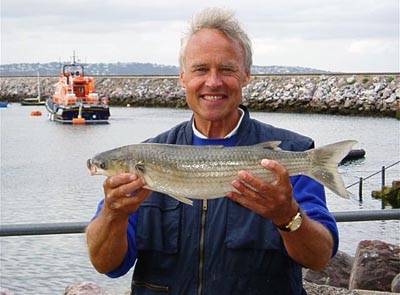 fishing Dartmouth sea angling torbay festival Devon uk charter boat shore plaice turbot bass river dart |
||
Harbour Mullet |
||
|
Last year I wrote a series of articles about Mullet fishing in the rivers Dart and Teign. However, upon reflection, for most anglers this is a very specialist area; - the rivers are not the easiest places to cut your Mullet “teeth”, as they are so susceptible to tidal movements, flood water and changes in temperature, not to mention the challenges that shallow and often crystal clear water can bring. Top Mullet anglers like Roy Repton, who fishes his local river, the Teign, would confirm that the methods that he uses would not necessarily transfer to the nearby Dart. The rivers fish differently and so you could spend a lot of time catching nothing whilst building up the necessary local knowledge and expertise. However, for the angler who wants to have a go at catching the elusive “grey ghosts”, do not despair. There are many less challenging venues, which given the right approach, will fish consistently and yield good dividends.
Holiday makers and anglers will have seen plenty of Mullet basking in West Country harbours and marinas. They may be amongst the most visible of sea fish but that doesn’t spell automatic success. Frustratingly some of the best venues are out of bounds as many harbours and marinas have a strict “no fishing” policy, so you need to check this out first. One venue which can be fished and which holds a good head of Mullet is Brixham Breakwater. This long, Victorian stone pier can produce fish along the whole of its length and on both sides, but traditionally it is the sheltered waters on the inside that are chosen. Any soft actioned rod of reasonable length can be pressed into action, (11 to 12 feet is fine). You need slightly heavier line than you might use on the rivers, somewhere between 5 - 6lb b.s. being a sensible option. Floats need to be heavier too and capable of carrying a number of swan shot, to hold out in the deeper water and to combat the effect of any cross wind. You can be fishing depths approaching 15 to 20 feet at some states of the tide so it is essential to rig up a sliding float, with a stop knot of nylon tied to the line, that can be adjusted as the tide rises and falls. Hooks in the size 6 to 10 scale will give you all the choices you might need. Groundbait can simply be mashed up bread but in commercial fishing harbours the Mullet are used to a supply of fish scraps, and so it makes sense to add mashed up soft oily fish, such as Mackerel and Sprats to the mix. If you are very brave and have strong nerves and understanding partners and neighbours you might want to leave it to “cook” for a few days. The smells this produces will be around 10 on the Richter scale, but undoubtedly it is capable of producing excellent results if you can stomach the appalling aromas this brings!!! Enough of the technical details. Ready to go! ……Best to choose a morning tide and ideally one with low water about two hours after you have started; I don’t know why, but catches always seem to be more successful than when fishing over the high tide period. You will have to climb down onto the newly uncovered boulders covered in wet seaweed. Take your time and be careful. It’s like walking on bars of soap, and it’s worth a few moments to pick out a comfortable spot. You don’t want to end up breaking a limb or smashing your tackle. Start off by pounding in some heavy balls of ground bait over the chosen spot before you start setting up. When you have the right depth, then use a piece of Mackerel flesh without the hard skin part. Sometimes the bites are immediate as soon as you cast in, but a more typical pattern is one where you keep introducing small balls of ground bait each cast, and after a while fish appear. A variety of species is likely to be attracted to this free bonanza of food, and quite often bold biting Mackerel will tear off showing tremendous power and speed on such light tackle. In a similar fashion Gar and Scad, together with other fish will also turn up. Using slightly heavier line is important as Mackerel will quickly fray ultra light line, and this might be to your cost when the line parts suddenly when attached to a big Mullet! Typically, if Mullet arrive on the scene, bites from smaller fish dry up. The float often slides away smoothly and decisively, but be alert too for lift bites, a sign that the fish are intercepting the bait on the drop. If that is the case adjusting the bait so it is further from the bottom is often the answer. Unlike river fish, which need a lightning fast reaction, it often pays to let the float go right away. Hooking the bites is generally much easier and although everyone misses some, sooner or later you will have that satisfying feeling of a powerful fish hooked on light line. Make sure that your clutch allows line to be taken from the reel and be prepared for a long and dogged fight, especially if you are lucky enough to hook into a big fish. Once netted, it pays to return the fish some distance from where it was captured. If you keep putting fish back in the same area that you are fishing the bites will quickly dry up, as any returned fish will quickly draw the shoal away. It is not impossible to hook all three varieties of Mullet during a session, although most of the fish will be Thick Lips. Over the last few years, the chance of big specimen Golden Greys has increased dramatically, with the increase in water temperatures. Thin Lips are more normally taken spinning Rag-baited spoons, but they will take bread and Mackerel on occasions. During the summer and autumn months there is always the chance of excellent sport, and with luck you could end up with a really big specimen. Most of the really large U.K. fish are taken from harbour locations, and if you are in the right place at the right time when that monster appears in your swim, it might be you! (Sounds like the advert for the Lottery; I guess catching that once in a lifetime fish is not dissimilar). The methods described here work well in many situations including fishing open sea rock marks. Harbours all over the U.K. within the Mullet’s range will readily produce fish, using bread or fish baits. This also applies to venues much further afield and I have had many Mullet in the Mediterranean, the Canaries and beyond, using this approach. Why not give it a try? Once you’ve hooked your first big Mullet you’ll be hooked for life. I still get a great buzz of anticipation every time I set out on a Mullet session, and that’s after forty years, so be warned.© Mike Bailey - 26th June 2006 |
||
